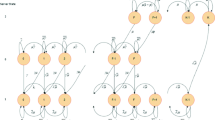Abstract
In this paper, we present the first results of an experimental study of a new dispatching strategy in unobservable queuing systems with parallel service. The main distinguishing feature of the considered system is the impossibility of observing its dynamic characteristics. A set of numerical examples covering various options for the input job stream, various length distributions of jobs, as well as a various number of heterogeneous servers is considered. All examples used the FIFO discipline. The new dispatching strategy was compared with the best algorithms known to the authors. In most examples, the new algorithm detects comparable (often better) values of the mean and variance of the dwell time and requires significantly fewer parameters to be determined for its tuning.
Similar content being viewed by others
Notes
Also sometimes referred to as job allocation strategies, routing strategies, or resource allocation strategies.
Note that this assumption is essential when applying the obtained in voluntary computing systems, which are characterized by the unreliability of computing nodes. The demonstrated effectiveness of the proposed strategy implies that it is applied to a subset of nodes with at least high availability.
In foreign literature—PAP (Probabilistic Allocation Policy) or RND (Random), or BS (Bernoulli Splitting). We recall that the RND strategy is described by set (p1, …, pN) of N numbers, i.e., probabilities pn of choice for the next job of server n.
These are strategies parameterized by infinite sequences {a1, a2, …, ai – 1, ai, …}, where an means that the nth job is sent to server an. In this paper, the SG algorithm from [6, p. 184] is used to generate an.
This means that the performances of the servers do not differ too much from each other, i.e., there are no servers that are so fast that it is profitable to send all jobs to them.
It may seem that the best c is also optimal for a system of parallel systems M/D/1 (see, for example, [8]). However, numerical experiments show that this is not the case. This is also additional evidence that the c value in the auxiliary process depends (in an unknown way) on the G distribution.
Another simple solution, which, however, does not guarantee optimality, is pn = \({{{{{v}}^{{(n)}}}} \mathord{\left/ {\vphantom {{{{{v}}^{{(n)}}}} {\sum\nolimits_{i = 1}^N {{{{v}}^{{(i)}}}} }}} \right. \kern-0em} {\sum\nolimits_{i = 1}^N {{{{v}}^{{(i)}}}} }}\).
It should be noted here that in the case of a multiprocessor system, this approach is no longer practically feasible.
For non-Markov systems close to optimal.
REFERENCES
M. Konovalov and R. Razumchik, “Improving routing decisions in parallel non-observable queues,” Computing 100 (10), 1–21 (2018).
M. G. Konovalov, R. V. Razumchik, “Minimize average residence time in non-observed systems with parallel service and fair processor separation discipline in servers,” Inf. Protsessy 19, 327–338 (2019).
S. S. Parkhomenko and T. M. Ledeneva, “Scheduling in volunteer computing networks, based on neural network prediction of the job execution time,” Int. J. Parallel, Emergent and Distributed Syst. 34, 430–447 (2019).
E. Lavoie and L. Hendren, “Personal volunteer computing,” in Proc. 16th ACM Int. Conf. on Computing Frontiers, (CF 2019), Alghero, Italy, April 30–May 2, 2019 (ACM, 2019), pp. 240–246.
T. M. Mengistu and D. Che, “Survey and taxonomy of volunteer computing,” ACM Comput. Surv. 52 (3), Art. ID 59 (2019).
A. Hordijk and D. A. van der Laan, “Periodic routing to parallel queues and billiard sequences,” Math. Methods Operat. Res. 59, 173–192 (2004).
S. F. Yashkov, Analysis of Queueing in a Computer (Radio i Svyaz’, Moscow, 1989) [in Russian].
E. Hyytiä, “Optimal routing of fixed size jobs to two parallel servers,” INFOR: Inf. Syst. and Operat. Res. 51, 215–224 (2013).
M. Konovalov and R. Razumchik, “A simple dispatching policy for minimizing mean response time in non-observable queues with SRPT policy operating in parallel,” Commun. ECM, 34 (1), 398–402 (2020).
W. Kraemer and M. Langenbach-Belz, “Approximate formulae for the delay in the queueing system GI=G=1 in Proc. 8-th Int. Teletr. Congress, (ITC), Melbourne, 1976 (ITC, 1976), pp. 2351–8.
M. G. Konovalov, Adaptive Information Processing Technique and Their Applications (IPI RAN, Moscow, 2007) [in Russian].
Funding
This study was supported by the Russian Foundation for Basic Research, grant 18-07-00692.
Author information
Authors and Affiliations
Corresponding authors
Additional information
Translated by A. Ivanov
Rights and permissions
About this article
Cite this article
Konovalov, M.G., Razumchik, R.V. New Policy for Routing Jobs to Unobservable Parallel Queues with FIFO Scheduling . J. Commun. Technol. Electron. 66, 737–744 (2021). https://doi.org/10.1134/S1064226921060176
Received:
Revised:
Accepted:
Published:
Issue Date:
DOI: https://doi.org/10.1134/S1064226921060176




